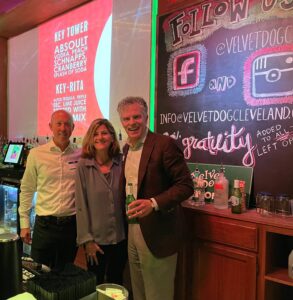KeyBank, headquartered in Cleveland, is the largest single corporate supporter of United Way of Greater Cleveland, with more than $2.13 million given in 2023 (and $3.3 million total for United Way organizations across the country). The roots of the firm go back to the formation of the Society for Savings by Samuel H. Mather in 1849. The bank built the first skyscraper in Cleveland—still on Public Square—and in 1890 added a much taller building immediately next to the original that became known as the Key Tower after the merger of Society Corp and Key in 1994.
Eric Fiala, KeyBank’s Head of Corporate Responsibility and Community Relations, says the relationship between the entities that became Key and United Way go back more than a century. “In the early 1900s, the Cleveland Chamber of Commerce created the Cleveland Federation for Charity and Philanthropy. This evolved into the Community Chest, which in 1919 had 92 members and was chaired by Samuel Mather—who happened to be the founder of the Society for Savings. So, we see a lot of connectivity between the KeyBank of today and what ultimately would be known as United Way.”
KeyBank’s philanthropy focuses on three areas—education, workforce development, and neighbors—and exists to design innovative programs that address the community’s needs.
Andrew J. “Randy” Paine III, Executive Vice President and President of Key Institutional Bank, represents another strong connection between KeyBank and United Way: he is the current board treasurer of United Way of Greater Cleveland, chair of the Finance Committee. He also serves on the Planned Giving and Resource Development committees. The philosophical alignment between the two organizations makes for a natural pairing, according to Paine: Paine sums up how he sees the corporate mission and its alignment with United Way: “Our purpose is to help clients and communities thrive. Key’s philanthropic priorities align very closely with United Way’s around economic mobility, health pathways, and housing stability.”
“United Way is a great facilitator and educator. It’s uniquely positioned to partner with companies, make connections, educate about where the greatest needs are, and how you can make the biggest impact.”
Andrew J. “Randy” Paine III, Executive Vice President and President of Key Institutional Bank
To that end, Paine and his colleagues at KeyBank have been impressed with United Way’s transformation in the past few years. “We’re very excited about how United Way has evolved,” he says, “and that’s because we want to see systemic change—we want to see investments that really change outcomes for underserved members of our communities.”
Caitlyn Bell is a Senior Lead Finance Analyst at KeyBank, and chair of United Way’s Emerging Leaders KeyBank branch. To her, one of the important developments in recent years is the way in which United Way continues to make advances in sharing data to highlight the impact that donors are making. “It’s been really cool to see how United Way can intervene with new technology,” she says. “For example, at the Community Hub for Basic Needs, you can see just by scanning a QR code the area and the metrics of what the 211 program is doing for Cleveland. The data and visuals really show what your money is going to—and I think that really helps when you’re asking people to donate money.”
Workplace Campaign Flexibility
KeyBank’s annual workplace campaign has been United Way’s top performer in all but one year since 2009. Paine thinks one reason for that success is that “employees can direct their dollars to specific local agencies . . . there’s a lot of flexibility with the workplace campaign that makes it really attractive.”
Fiala elaborates, “I think it comes back to that purpose of helping clients and communities thrive . . . inherent in our culture is this commitment to driving impact in our communities. It’s embedded in who we are as a company.” That value placed on giving back, he believes, is also part of the character of the city itself. “The people of Cleveland make the city great—the grit, the work ethic. Why do you give back? Because it’s what you do.”
“The workplace campaign really unites all of us as an employee base. And I really like that you can see the hands-on impact that we can make in the community.”
Caitlyn Bell, Senior Lead Finance Analyst at KeyBank
To Bell, the combination of shared purpose and being able to see how one’s support is making a difference is compelling. “The workplace campaign really unites all of us as an employee base. And I really like that you can see the hands-on impact that we can make in the community.”
“We say in the foundation world that giving away money is easy, but giving it away well is really hard,” according to Fiala “United Way is very helpful in assessing the impact of your giving. Everybody’s personal motivations for giving are different, but there’s also a business case for giving back. We talk about the concept of shared value: how do we create shared value for multiple stakeholders at a time? Ultimately, when our communities are thriving, our business has more opportunity to thrive.”
“United Way is a great facilitator and educator,” says Paine. “It’s uniquely positioned to partner with companies, make connections, educate about where the greatest needs are, and how you can make the biggest impact. United Way is tackling really tough problems, helping people move from poverty to having fulfilling work and real economic opportunity. I personally have had the fortune to have a career at KeyBank and to have had a lot of opportunity. It’s important to me to give back to the communities that have helped Key be so successful. I think it’s incumbent on all of us to give back.”
This article originally appeared in Give for Good, which is published by United Way of Greater Cleveland for our friends and benefactors. For more information on our Workplace Campaigns, please visit our Workplace Campaign page or email Sandra Fletcher, Senior Associate Director, Corporate Philanthropy at sfletcher@unitedwaycleveland.org
.
